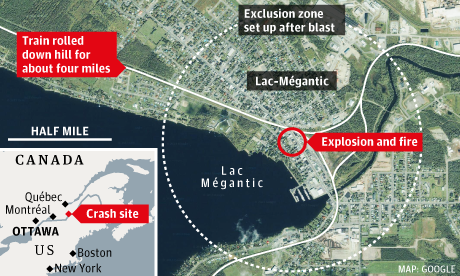In the 680News round-up of details from the Lac-Mégantic explosion and fire, there’s a fascinating bit of news I hadn’t heard before:
Responding to a reporter’s question during Saturday’s news conference, Lauzon confirmed that firefighters in a nearby community were called to a locomotive blaze on the same train a couple of hours before the derailment. Lauzon said he could not provide additional details about that fire since it was in another jurisdiction.
This may or may not have any bearing at all on the subsequent runaway and crash, but it’s of interest. So far, there have been three reported deaths from the explosions and fire, with at least 40 people still unaccounted for. The PM will be visiting the town soon:
Prime Minister Stephen Harper is planning to visit this Quebec community Sunday, one day after powerful explosions caused by a train derailment levelled the town’s downtown core and killed at least one person, with police predicting the death toll would rise.
“We do expect we’ll have other people who will be found deceased unfortunately,” Lt. Guy Lapointe, a spokesman with Quebec provincial police, told a news conference Saturday night.
Authorities in Quebec say two more people are confirmed dead in the train derailment and massive fire in Lac-Mégantic to bring the declared death toll to five.
“We also expect that down the line … there will be more people reported missing than people actually found dead.”
Lapointe refused to give any estimate of people unaccounted for because emergency crews couldn’t reach a two-kilometre-square section of the town out of concern that five of the train’s tanker cars could still explode.






